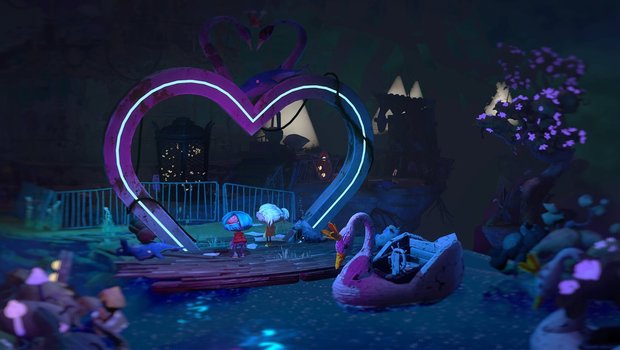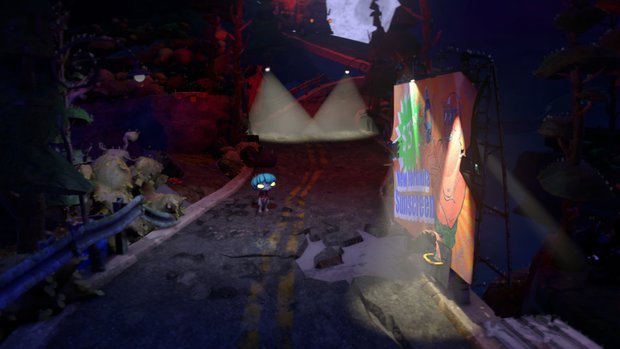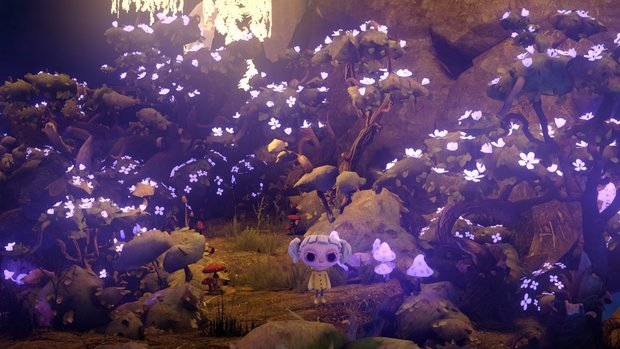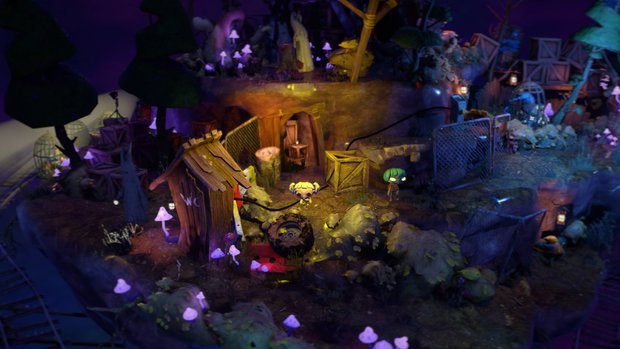Gloomy Eyes review

- 0 Comments
Burton-esque puzzler is a dark but lovely vision to behold, needing just a little more spark of gameplay inspiration
Romeo and Juliet may be the quintessential star-crossed lovers, but at least they had the benefit of both being alive. (Well, you know, until...) Not so the two protagonists of Gloomy Eyes, a 3D puzzle-adventure adapted from the 2019 VR movie of the same name, in which only one of them belongs to the land of the living. The other – the titular Gloomy – is a zombie who awakens to a world without sun. Gloomy knows it could be so much more if only the light would come back, so he embarks on a quest to find and return it, completely unaware that a still-breathing counterpart named Nena is attempting the same thing. The result is a bleak but beautiful Burton-esque experience, both visually and narratively, and while the gameplay is never particularly deep and not as intuitive as it could be, it’s a welcome addition to zombie lore that requires using one’s brain rather than eating other people’s.
Gloomy Eyes can be played with either a keyboard/mouse or gamepad, the latter feeling far more natural but certainly not necessary. It’s split into fourteen self-contained levels, but within each chapter are varying amounts of freedom to explore. Some are entirely linear, channeling you down the only available path, while others open up for more puzzle-solving opportunities. Mechanically and structurally it resembles the likes of Little Nightmares, but this is no horror game. The always-stationary trapped undead will snatch up unsuspecting little girls who wander too close, and even harmless zombie boys are persona non grata to pretty much everyone still living, so there is some danger involved. Fortunately, getting caught means nothing more than a quick auto reload of the nearest generously spaced checkpoint. The real story here isn’t about monsters rampaging the earth, but the tragic human drama of a crumbling civilization turned against itself, and the two unlikely heroes trying desperately to save it against all odds.
I referred to “lovers” earlier but technically Gloomy and Nena aren’t that, as they’re only children. And yet Gloomy Eyes is ultimately a love story nevertheless. At first it’s a mournful love for a world gone horribly awry, and a pining for the missing sun – not a giant ball of gas in space but a fantastical creature who got fed up with mankind’s idiocy, yet could perhaps be convinced to return if given reason to hope again. Then, when the two young protagonists meet early on, there’s an almost spiritual connection between them; a kinship that binds them, knowing that the way forward means setting aside differences and working together. Just one problem: Nena’s own uncle is the Nosferatu-looking head priest of a cult hell-bent on eradicating zombiekind once and for all, and is none too happy that his wayward niece has run away with one.

It’s a mostly wordless tale, helped along only by a narrator chiming in with his experiences as the gravekeeper who buried Gloomy and now watches the pair’s exploits from afar. Colin Farrell lent his talents to the role in the VR movie but does not do so here. Fortunately his stand-in Eric Nolan does an admirable job, sounding very much like Farrell with an appropriately melancholy delivery and light Irish lilt. There aren’t many ambient sounds beyond those of rain, changing footsteps on different surfaces, and the groans of trapped zombies, but the music suits the game’s tone – sometimes haunting violins, sometimes a bit jaunty, and sometimes repetitive, depending on how long you stay in an area. (I was pretty sick of carnival music once I finally escaped the amusement park.) Overall the score gives off more of an Addams Family vibe than full Danny Elfman, Tim Burton’s frequent collaborator.
I don’t want to harp on the Burton angle too much, but it’s impossible to escape the director’s influence on the game’s creepy-cute 3D aesthetic, twisted in all the right ways with just a touch of whimsy. Nothing overtly derivative (although squint at the gravekeeper and you just might see Jack Skellington), and as a big fan of Beetlejuice and other classic Burton films, I certainly don’t say this as a bad thing. Besides, it entirely fits the circumstances here. The run-down ruins of a civilization destroyed, from the children’s old school to a long-abandoned fairgrounds (complete with haunted house attraction) to a lighthouse on the shore, make for a marvelous playground of debris and unusual architecture that are as instantly familiar as they are now damaged beyond repair. The character models are wonderfully caricatured, whether the protagonists with their expressive big eyes (coughBurtoncough) and miniature bodies, the oafish blue-skinned zombies unable to free themselves (one even clumsily caught in a prop guillotine), or the menacing cultists in double-pointed white hoods resembling another racially charged hate group, only this time hunting the undead.

The ever-pervasive darkness casts an appropriate pall over everything. In some particularly inky-black spaces, an artificial light will illuminate your immediate surroundings as you approach (and then smartly fade again behind you), though the light radius is extremely small and even fully lit the view is fairly dim. The deep shadows are pierced only the pretty luminescent plants and mushrooms of a mazelike forest, the vivid green goo of toxic swamps, or Gloomy’s own glowing yellow eyes. Better still is how the limited lighting factors into the gameplay. While living people are impervious to light, it seems zombies have a fierce aversion to anything stronger than the moon. That means whenever you control Gloomy, you must avoid any bright lights in his path lest you get trapped by their beams. It sounds basic, but it’s so enticing in the darkness that several times I completely forgot that light was my enemy and I wandered blissfully into my own (momentary) demise.
But with the good comes the bad, and although the lighting is sufficient to see where you are, it sometimes isn’t quite enough to see where you’re going. The camera follows along as you move, offering virtually no manual control to look around, and the angle is often so low that it’s difficult to make out details in the background. A few times I literally stumbled into a pathway I didn’t even realize was there. Other times I couldn’t go any farther without any clear reason why. The way Gloomy Eyes tries to compensate for this is a nifty overview that can be accessed nearly any time, offering a wonderful diorama-style look at the entire level. The isometric view here can be zoomed in and out and the camera fully rotated, but it swivels on a pre-set horizontal path with no vertical control, so its usefulness for planning is limited. It’s certainly better than nothing, but not nearly as good as a seamlessly integrated camera control system.
Some shorter levels see you play only as one character or the other, but most of them involve both Gloomy and Nena working together – or rather, working separately but cooperatively. (Which is just as well, as there’s no convenient way to make them travel together.) You can switch between the two at will in order to overcome obstacles such as getting Gloomy past lights, Nena past zombies, or building bridges and activating lifts to enable both to reach exits or goals in order to move on.
Each protagonist has their own distinct strengths and weaknesses: Gloomy can push and pull certain heavy objects and throw items at designated highlighted targets, yet he’s unable to jump even small gaps or climb ladders or vines. Fortunately Nena can do so, along with using man-made equipment like levers and buttons. There is no inventory but both Gloomy and Nena can hold one item at a time and even hand it over to the other, though each is limited to using only what they’re able. Apparently Gloomy doesn’t understand the concept of fuses, for example, while the noodle-armed Nena has no use of bricks for throwing.

These built-in limitations work effectively at gatekeeping progress to make you think your way through the levels, but they can feel a little artificial at times, and often not particularly intuitive. Sometimes an objective is clearly laid out – collect parts to rebuild a swan boat for crossing the lake – but often there’s no real direction beyond getting through and getting out, figuring out everything in between as you go along. Fortunately the levels are small enough that some exploration and experimentation will begin to clarify your task. Occasionally I found myself wandering aimlessly early on, and yet almost always I soon found myself making progress and feeling pretty smart about it.
“Almost always,” I said. The aforementioned carnival level gave me fits, not because it’s unfair but because it involves a number of moving parts and is perhaps the worst offender of intrusive darkness making it difficult to plan properly. But that’s nothing compared to the fact that in trying to maneuver Gloomy somewhere he wasn’t intended to go, I got him stuck in place and unable to move further in any direction. I figured a quick reload of the last checkpoint ought to do it, but nope. Still stuck. There is a “restart” option available in the Escape menu, but since it promises (threatens?) to “start over from the beginning,” I didn’t dare gamble on being sent all the way back to the very first scene. (Totally helpful spoiler alert: it actually does just restart the current level – exactly what I needed.) Instead I exited out to the main menu to the chapter select screen, only to discover that it dropped me at the same mid-level checkpoint, forcing me to replay the entire previous level as well to get back to where I was. Ugh. That wasn’t the only time I got a character stuck in place, either, though in the other cases at least I was bailed out by reloading a checkpoint.
While most of Gloomy Eyes is puzzle-based, there are a few more action-oriented sequences. A handful of stealth sections require sneaking around patrolling guards, running or hiding when necessary. These are quite forgiving, though – so much so, a couple of times you can sneak right up behind a sentinel and pickpocket some much-needed keys. There’s really nothing in the way of platforming; even when playing as Nena, you can only hop over predetermined gaps (indicated by the now-familiar yellow markers) and she’ll do so automatically without so much as a jump button. It’s not until near the end that you’ll face your first full-on action sequence, a kind of preliminary arena battle preparing you for the final showdown still to come. But even these are pretty lightweight. Instead of direct combat, you’ll have to dodge lasers or other projectiles long enough to make use of the environment to your advantage. I can’t imagine too many players having difficulty with it. Still, it’s a definite departure from the far more cerebral puzzle solving up to that point.
Other than an increase in complexity – a couple later levels involving continually moving pulley lifts and rail carts into position are quite clever – these late-stage battles are really the only change to a fairly simple formula established early on. At less than four hours or so in total, the game ends before it wears out its welcome, but don’t be expecting any new abilities to unlock or surprises to keep things fresh, even to retrieve the optional collectibles scattered around. The only real surprise is saved for the story, which may seem like a predictable (if unusually grim) fairy tale but isn’t shy about zigging narratively where most would comfortably zag before all is said and done.
Final Verdict
In some ways, Gloomy Eyes the game both benefited and suffered from its original conception as a non-interactive VR short film. The stunning aesthetic and wistful poignancy of the tale were strong foundations to build upon, but the “self co-op” gamification of the experience isn’t entirely smooth. The dual-character challenges are welcome, to be sure, and for the most part they’re enough for a couple of cozy evenings of (mostly) puzzle solving. And yet it’s hard not to feel like they’ve been tacked on at times (because they were), and the presentation isn’t as user-friendly as it should be with the player in control. Still, it’s a charming production that’s solid fun while it lasts, and even if you go in feeling glum, it’s likely to leave you with a smile on your face.
Hot take
Gloomy Eyes is a dark but lovely fairy tale, revived from its previous VR-exclusive short film form and given new life with a welcome if fairly shallow layer of gameplay.
Pros
- Gorgeous Burton-esque visual design
- Lovely tale with a narrative surprise or two
- Engaging dual-character puzzles
- Who needs a Hollywood A-lister for wonderful tone-setting narration?
Cons
- Gameplay never gets much deeper than it started
- Some bugs and a restrictive checkpoint system can spell trouble
- Late-game action sequences feel out of place
Jack played Gloomy Eyes on PC using a review code provided by the game's publisher.











0 Comments
Want to join the discussion? Leave a comment as guest, sign in or register in our forums.
Leave a comment